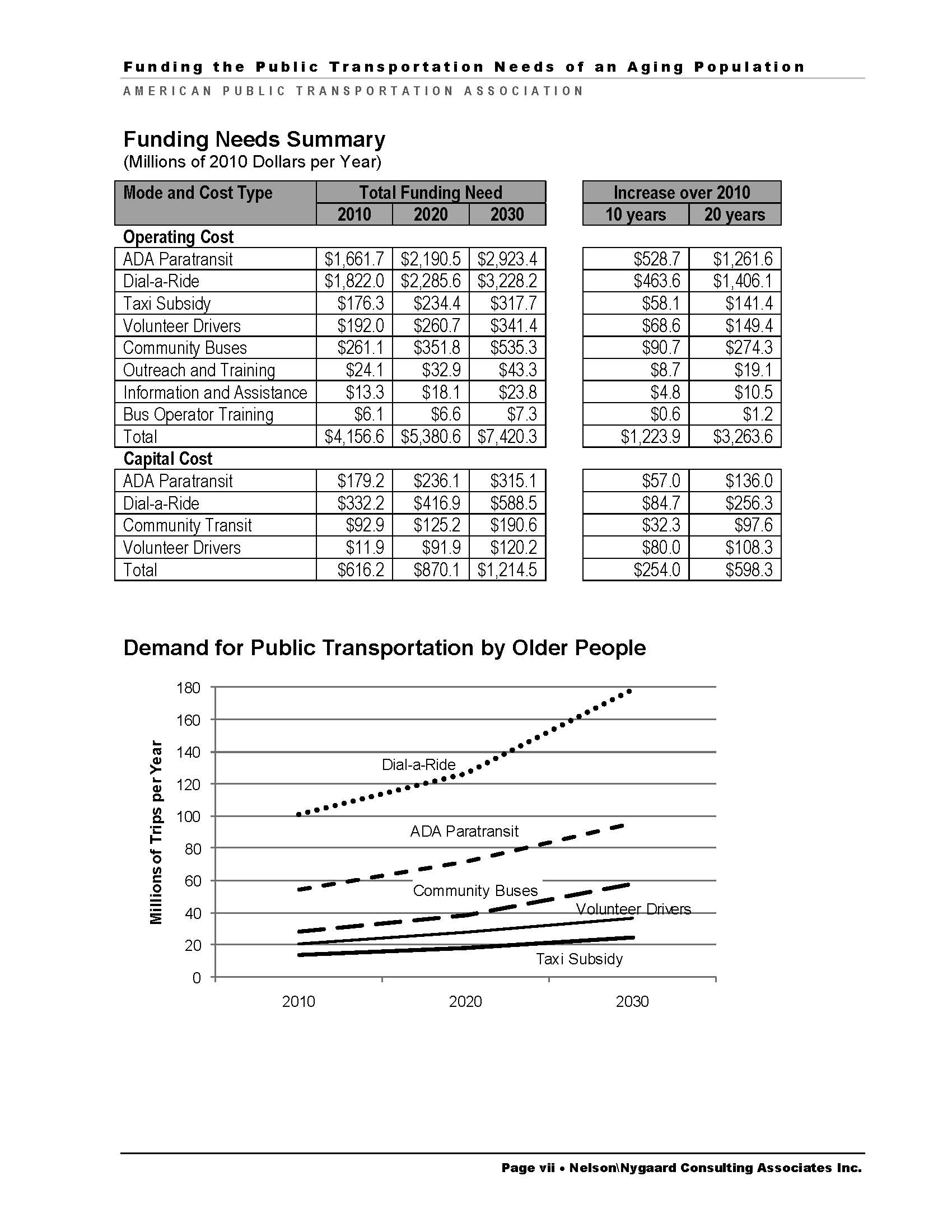AMERICAN PUBLIC TRANSPORTATION ASSOCIATION
Executive Summary
Rapid growth in the number of older people in the United States during the coming decades will lead to greatly increased needs for expanded and enhanced public transportation services. This report: a) identifies the range of actions that will be needed to expand mobility options for older people, including accessible public transportation services; b) quantifies the demand for these public transportation services; and c) estimates the funding that will be needed to provide them.
Needed Actions
Needed actions have been identified by means of a review of the extensive literature on this subject. The actions needed to expand mobility options for older people include:
- Enhancements to fixed-route public transportation operations and planning such as additional bus operator training, incorporating travel needs of older people in route planning and stop placement, and coordination with other agencies and transportation providers
- Enhancements to public transportation vehicles such as low-floor buses, kneeling buses, improved interior circulation, additional stanchions and grab bars, ergonomic seating designed for older riders, and accessibility features either required or encouraged by ADA like lifts and ramps, larger letters on head signs, and stop announcements
- Actions to help older people take advantage of existing services, like presenting information in ways that are easy to read and as clear as possible, information and assistance programs to connect older people with appropriate services, and outreach and training programs
- Expansion of supplementary services including flexible route and community transportation services, ADA complementary paratransit, non-ADA demand-responsive services, taxi subsidy programs, and volunteer driver programs
- Application of universal design strategies at transit facilities, bus stops, and on streets and sidewalks in the immediate vicinity of transit facilities and stops
These are the actions of greatest concern to public transportation agencies, but they are not the only actions needed. Other important actions include assuring supportive services to caregivers who provide transportation, encouraging further development of unsubsidized private transportation services, increasing the availability of accessible taxicabs, coordinating with nonemergency medical transportation provided under Medicaid and Medicare, and supporting modifications to automobiles and roadways to increase the safety of older drivers.
The analysis only estimates funding needs for those actions involving public transportation services, and only for those actions for which a portion of the cost can be clearly connected with growth in the older population. These actions and services are: ADA complementary paratransit,mnon-ADA dial-a-ride services, taxi subsidies, volunteer driver programs, community bus services, outreach and training, information and assistance, and bus operator training. Only the portion of cost due to increasing numbers of older people has been estimated. No distinction has been made regarding whether the needed services would be provided by public transit operators, cities, counties, or community organizations.
Expected Growth of the Older Population in the United States
The aging of the Baby Boom generation (people born between 1946 and 1964) is expected to produce a 79% increase in the number of people over the age of 65 in the next 20 years. For the next ten years, most of the growth will be in the 65 – 74 age group, which will grow 51% by 2020. People in this age range typically have relatively few mobility limitations but still have unique travel needs. In the decade after 2020, there will be continued growth in the 65 – 74 age group but there will be especially rapid growth in the number of people age 75 – 84, whose numbers are expected to increase by 55%. People in this age range commonly have many more mobility limitations.
Download executive summary (PDF): Funding the Transportation Needs of an Older Generation
Download full report (PDF): Funding the Transportation Needs of an Older Generation
Tags: American Public Transportation Association, APTA, Baby Boomers, Population Growth, Senior Citizens







 RSS Feed
RSS Feed